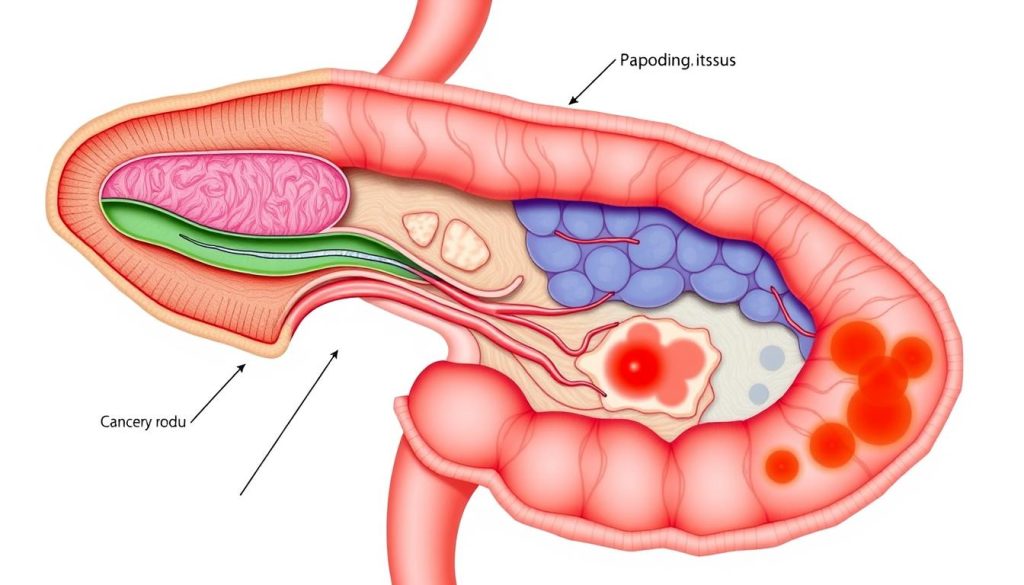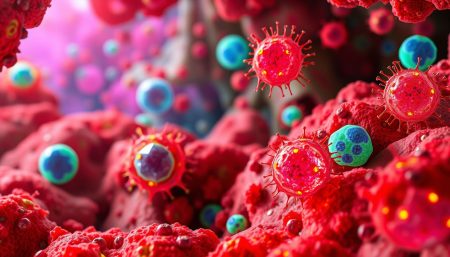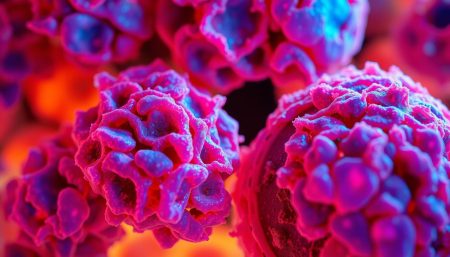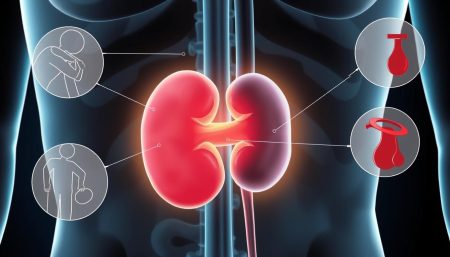Appendiceal cancer is a rare disease that starts in the appendix, a small pouch near the colon. It affects about 1 in 100,000 people in the U.S. each year. Knowing about this disease is key for early detection and treatment.
Appendiceal tumors can grow slowly or quickly. Some stay in the appendix, while others spread to other parts of the body. This makes finding and treating them hard, needing special skills.
Finding appendiceal cancer early is very important. Many cases are found by accident during tests or surgeries for other reasons. This shows how important it is to get regular health checks and watch for body changes.
We will look into the types, causes, symptoms, and treatments of appendiceal cancer. This information helps both patients and doctors in the battle against this rare but serious disease.
What is Appendiceal Cancer and Its Types
Appendiceal cancer is a rare cancer that starts in the appendix. This small, finger-shaped organ can develop different types of tumors. Knowing these types is key for the right diagnosis and treatment.
Mucinous Adenocarcinoma of the Appendix
Mucinous adenocarcinoma is a type of appendiceal cancer. It makes a jelly-like substance called mucin. This cancer can spread to the abdominal cavity, causing pseudomyxoma peritonei. Treatment usually includes surgery and chemotherapy.
Goblet Cell Carcinoid Tumors
Goblet cell carcinoid tumors are rare and aggressive. They have features of both adenocarcinomas and neuroendocrine tumors. Quick detection is essential for successful treatment.
Neuroendocrine Tumors
Neuroendocrine tumors, or carcinoid tumors, come from hormone-producing cells in the appendix. They grow slowly and have a better outlook compared to other types of appendiceal cancer.
Colonic-Type Adenocarcinoma
Colonic-type adenocarcinoma of the appendix is like colon cancer. It can be aggressive and needs extensive surgery and chemotherapy. Early detection and proper staging are vital for effective treatment.
Anatomy of the Appendix and Cancer Development
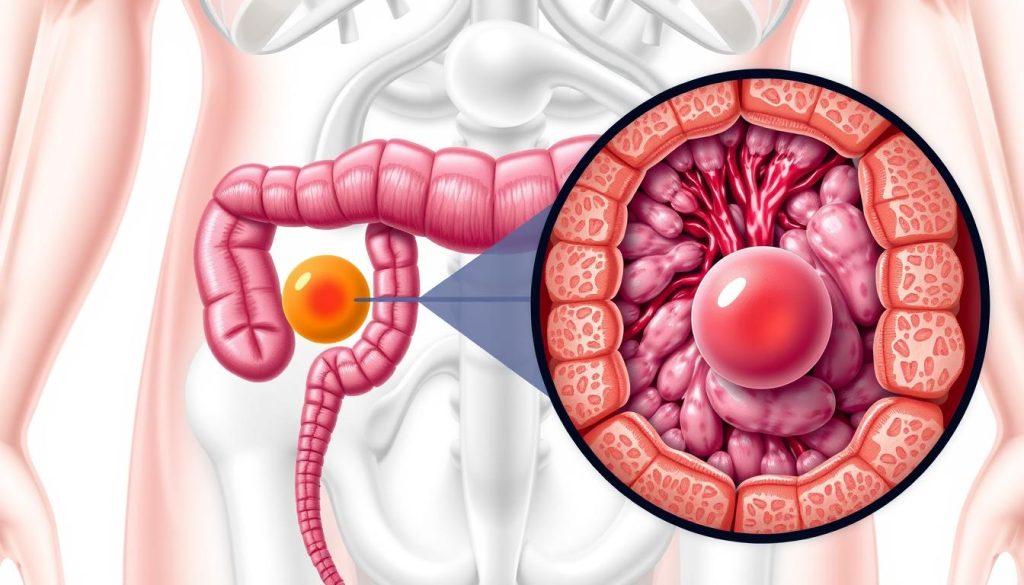
The appendix is a small, finger-shaped pouch attached to the large intestine. Its exact function is debated, but it aids our immune system. Knowing its anatomy helps us understand how tumors form.
This organ is about 4 inches long and has special lining tissue. When cells in this lining grow abnormally, a tumor might form. These growths can be benign polyps or malignant cancers.
Appendiceal neoplasms start with tiny cell changes in the appendix lining. These cells multiply, creating a mass. As the tumor grows, it can block the appendix or spread to nearby tissues.
- Mucinous tumors produce a jelly-like substance
- Carcinoid tumors arise from hormone-producing cells
- Adenocarcinomas develop from gland cells
Finding appendiceal tumors early is hard because they are hidden. Symptoms show up when the growth is big or has spread. This highlights the need for regular check-ups and knowing warning signs.
Risk Factors and Causes of Appendiceal Cancer
Knowing the risk factors for appendiceal cancer is key. It helps both individuals and doctors stay alert. While we don’t know the exact causes, research has found several possible factors.
Genetic Predisposition
Some people might be more likely to get appendiceal cancer because of their genes. Certain syndromes, like Lynch syndrome, can raise the risk of many cancers, including appendix cancer.
Environmental Risk Factors
Being around certain environmental factors might also increase the risk of appendiceal cancer. This includes smoking, exposure to chemicals, and what we eat. Researchers are looking into how these might affect cancer risk.
Age and Gender Considerations
Appendiceal cancer can happen to anyone, but it’s more common in adults over 50. Some studies show slight differences in how often it happens in men and women, but the differences are small.
| Risk Factor | Impact on Appendiceal Cancer Risk |
|---|---|
| Age over 50 | Increased risk |
| Genetic syndromes | Potentially higher risk |
| Smoking | Possible increased risk |
| Gender | Slight variations observed |
Having risk factors doesn’t mean you’ll definitely get appendiceal cancer. Regular health checks and talking to your doctor can help catch it early. This is important for managing this rare cancer of the appendix.
Early Warning Signs and Symptoms
It’s hard to spot the early signs of appendiceal cancer because they can look like other stomach problems. Knowing these signs is key to catching the disease early and treating it right.
Common Physical Symptoms
People with appendiceal cancer might feel:
- Abdominal pain, mainly on the lower right side
- Bloating or feeling like their belly is bigger
- Changes in how often they go to the bathroom
- Unexplained weight loss
- Nausea or vomiting
Secondary Complications
As the cancer grows, it can cause:
- Appendicitis
- Bowel obstruction
- Peritonitis (inflammation of the abdominal lining)
- Pseudomyxoma peritonei (mucin buildup in the abdomen)
When to Seek Medical Attention
See a doctor if you have:
- Persistent abdominal pain that lasts more than a few days
- Sudden, severe abdominal pain
- Prolonged changes in bowel habits
- Unexplained weight loss with other symptoms
Spotting appendiceal cancer early can greatly improve treatment results. If you notice any worrying symptoms, don’t wait to get medical help.
| Symptom | Possible Indication | Action Required |
|---|---|---|
| Persistent right lower abdominal pain | Appendicitis or appendix tumor | Immediate medical evaluation |
| Unexplained weight loss with abdominal discomfort | Potential malignancy | Schedule doctor appointment |
| Sudden, severe abdominal pain | Possible appendix rupture | Emergency room visit |
| Gradual increase in abdominal girth | Pseudomyxoma peritonei | Consult specialist for assessment |
Diagnostic Procedures for Appendiceal Neoplasms
Finding an appendix tumor early is key to treating it well. Doctors use different methods to accurately diagnose appendiceal neoplasms. These steps help find out what kind of tumor it is and how big it is.
Imaging tests are very important in finding appendiceal tumors. CT scans show detailed pictures of the abdomen, spotting abnormal growths. MRI scans give even clearer images, helping doctors see how big the tumor is and if it has spread. Ultrasounds can also find appendiceal masses, when other tests can’t.
Blood tests are also used to look for tumor markers. These proteins can show if there’s a certain type of appendiceal neoplasm. If CEA (carcinoembryonic antigen) or CA-125 levels are high, it might mean there’s an appendix tumor.
A biopsy is the best way to confirm appendiceal cancer. It involves taking a small piece of tissue from the tumor for a closer look. Doctors might do a colonoscopy to get to the appendix and take biopsy samples.
| Diagnostic Procedure | Purpose | Invasiveness |
|---|---|---|
| CT Scan | Detailed imaging of abdominal structures | Non-invasive |
| MRI | High-resolution tumor visualization | Non-invasive |
| Blood Tests | Tumor marker detection | Minimally invasive |
| Biopsy | Definitive tumor diagnosis | Invasive |
Spotting appendiceal neoplasms early can lead to better treatment results. If you have ongoing belly pain or other symptoms that worry you, see your doctor right away. They can do the right tests and figure out what’s going on.
Understanding Pseudomyxoma Peritonei (PMP)
Pseudomyxoma peritonei (PMP) is a rare condition often linked to appendiceal cancer. It happens when tumor cells that produce mucin spread in the abdominal cavity. This section will explore how PMP develops, its health effects, and treatment options.
Development and Progression
PMP usually starts in the appendix. As the tumor grows, it can rupture. This releases cancer cells into the abdomen. These cells then produce mucin, a jelly-like substance.
This substance builds up over time. It can cause abdominal swelling and discomfort.
Impact on Overall Health
The health effects of PMP can be severe. As mucin builds up, it can press on organs. This can lead to digestive issues, breathing problems, and weight loss.
If left untreated, PMP can be life-threatening. It can cause organ dysfunction and nutritional deficiencies.
Treatment Approaches for PMP
Treatment for PMP often includes surgery and chemotherapy. The main goal is to remove as much of the tumor and mucin as possible. Here’s a breakdown of common treatment approaches:
| Treatment | Description | Effectiveness |
|---|---|---|
| Cytoreductive Surgery | Removal of visible tumors and affected tissues | High for early-stage PMP |
| HIPEC | Heated chemotherapy applied directly to abdominal cavity | Improves survival rates |
| Systemic Chemotherapy | Traditional chemotherapy given through IV | Moderately effective for advanced cases |
Early diagnosis and treatment of appendiceal cancer can prevent PMP. Regular check-ups and awareness of symptoms are key. They help with timely intervention and better outcomes.
Staging and Grading of Appendix Tumors
Understanding the staging and grading of appendix tumors is key for effective treatment. Doctors use these systems to figure out how big the tumor is and how to treat it.
Staging shows how far the tumor has spread. It looks at the tumor’s size, if it has grown into nearby tissues, and if it has reached lymph nodes or distant organs. The TNM system is often used, with T for tumor size, N for lymph nodes, and M for metastasis.
Grading examines how abnormal the cancer cells look under a microscope. Low-grade tumors grow slowly and are less likely to spread. High-grade tumors grow faster and are more aggressive. This helps doctors predict how the appendiceal neoplasm might behave and how it will respond to treatment.
Together, staging and grading give a full picture of the appendix tumor. This helps doctors create treatment plans that fit each patient’s needs. It balances the need for strong treatment with keeping the patient’s quality of life good. Regular check-ups and tests are key to see how the tumor is doing and if it has changed.
Treatment Options and Modern Approaches
Treating appendiceal cancer needs a plan made just for you. Doctors look at many things to make the best treatment plan. Let’s look at the main options for those facing this tough diagnosis.

Surgical Interventions
Surgery is often the first step against appendiceal cancer. The type of surgery depends on the tumor’s size and spread. In some cases, a more detailed surgery is needed to remove tumors in the abdomen.
Chemotherapy Protocols
Chemotherapy is key for appendiceal adenocarcinoma. It’s used before surgery to shrink tumors or after to kill any left. The type and length of treatment depend on the cancer’s stage and type.
Targeted Therapies
New advancements have brought targeted therapies for appendiceal cancer. These treatments target specific molecules in tumors. They can be more effective and have fewer side effects than traditional chemotherapy.
Your healthcare team will help choose the best treatments for you. They’ll consider your health, the cancer’s details, and your wishes. This way, they’ll make a plan that gives you the best chance to recover.
HIPEC Treatment for Peritoneal Mucinous Carcinomatosis
HIPEC treatment gives hope to those with peritoneal mucinous carcinomatosis from appendiceal cancer. It’s a new way to fight cancer in the belly. It uses surgery and heated chemotherapy to kill cancer cells.
Procedure Overview
First, surgeons remove any visible tumors. Then, heated chemotherapy is spread all over the belly. This method targets tiny cancer cells left after surgery.
The heat makes the chemotherapy work better. This helps many patients live longer and healthier lives.
Recovery and Success Rates
Recovering from HIPEC takes 4-8 weeks. Patients usually stay in the hospital for 1-2 weeks after the treatment. How well it works depends on the cancer’s stage and the patient’s health.
Studies show it can lead to better survival rates than other treatments for some cases of appendiceal cancer.
| HIPEC Aspect | Details |
|---|---|
| Procedure Duration | 6-12 hours |
| Hospital Stay | 1-2 weeks |
| Full Recovery Time | 4-8 weeks |
| 5-Year Survival Rate | Up to 70% for select cases |
HIPEC is a promising treatment for peritoneal mucinous carcinomatosis from appendiceal cancer. It’s a tough treatment, but it can greatly improve life for those who can have it.
Managing Side Effects During Treatment
Treatment for appendiceal cancer can cause many side effects. Patients may feel physical discomfort and emotional challenges. It’s key to understand and manage these effects to keep quality of life high during treatment.
Common physical side effects of appendix malignancy treatment include:
- Nausea and vomiting
- Fatigue
- Hair loss
- Changes in appetite
- Skin irritation
To deal with these symptoms, patients can try the following strategies:
- Eat small, frequent meals to manage nausea
- Get plenty of rest and engage in light exercise when possible
- Use gentle hair care products and consider wearing a wig or scarf
- Consult a nutritionist for diet recommendations
- Apply soothing lotions to irritated skin
Emotional side effects are also important to address. Patients may feel anxious, depressed, or have mood swings. Getting support from family, friends, or professional counselors can help. Joining support groups for appendiceal cancer patients can offer emotional connections and practical advice.
Remember, every patient’s experience with appendix malignancy treatment is unique. It’s vital to talk openly with your healthcare team about any side effects. They can provide tailored solutions and adjust your treatment plan if needed. This ensures the best possible outcome and quality of life.
Recovery and Follow-up Care
After treatment for appendiceal cancer or an appendix tumor, patients start a critical recovery phase. This time needs careful healing and watchful monitoring for the best results.
Post-Treatment Monitoring
Regular check-ups are key for those treated for appendiceal cancer. These visits include blood tests, scans, and physical exams. Doctors look for signs of cancer coming back or new growths. They adjust follow-up plans based on each patient’s risk.
Lifestyle Modifications
Patients often need to change their daily habits to aid in recovery and prevent future health problems. Eating a balanced diet with fruits, veggies, and whole grains boosts the immune system. Gentle exercise, as okayed by doctors, helps keep strength and well-being up.
Long-term Survival Rates
Survival rates for appendiceal cancer depend on the tumor type and stage. Early detection and treatment greatly improve chances. Five-year survival rates range from 67% to 97% for localized tumors, showing the value of early action and thorough care.
| Stage | 5-Year Survival Rate |
|---|---|
| Localized | 88% |
| Regional | 78% |
| Distant | 32% |
Recovering from appendiceal cancer is a long journey. With the right care and lifestyle changes, many patients live fulfilling lives after treatment. Ongoing research aims to better understand and manage this rare cancer.
Latest Research and Clinical Trials
The field of appendiceal cancer research is moving fast, bringing new hope to patients. Scientists are looking into new treatments and ways to find cancer early. This could lead to better results for those with appendiceal neoplasms.

Recent studies have been on targeted therapies for certain types of appendiceal cancer. These treatments aim to kill cancer cells without harming healthy tissue. This could mean fewer side effects and a better life for patients.
Clinical trials are testing new mixes of chemotherapy drugs for appendiceal cancer. Researchers are also exploring immunotherapy. This uses the body’s immune system to fight cancer cells.
| Research Area | Potential Impact |
|---|---|
| Targeted Therapies | Improved efficacy, reduced side effects |
| Immunotherapy | Enhanced immune response against cancer cells |
| Diagnostic Techniques | Earlier detection, more accurate staging |
New diagnostic techniques are also showing promise. Advances in imaging and biomarker tests could help find appendiceal neoplasms sooner. This could lead to better treatment results.
Patients interested in clinical trials for appendiceal cancer should talk to their healthcare team. These studies offer access to the latest treatments. They also help advance cancer research.
Support Resources and Patient Communities
Living with appendiceal cancer or an appendix malignancy can be tough, but you’re not alone. Many groups offer support and resources for patients and their families. The Appendix Cancer Connection provides a wealth of information and connects individuals facing similar experiences. Their online forums allow you to share your journey and learn from others.
Support groups are key in coping with appendiceal cancer. The Appendix Cancer Pseudomyxoma Peritonei Research Foundation hosts regular meetups. Here, you can find emotional support and practical advice. These gatherings offer a safe space to discuss your concerns and celebrate milestones with people who truly understand.
Educational resources are vital for managing appendiceal cancer effectively. The National Organization for Rare Disorders offers guides on appendix malignancies, treatment options, and ongoing research. By staying informed, you can actively participate in your care decisions and feel more empowered throughout your journey.
Remember, reaching out for support is a sign of strength, not weakness. Connecting with others who share your experiences can provide comfort, hope, and valuable insights as you navigate life with appendiceal cancer. Don’t hesitate to explore these resources and find the support that best fits your needs.
FAQ
Q: What is appendiceal cancer?
A: Appendiceal cancer is a rare disease that starts in the appendix. This is a small pouch attached to the colon. It includes different types like mucinous adenocarcinoma and goblet cell carcinoid tumors. Each type needs its own treatment plan.
Q: What are the early warning signs of appendiceal cancer?
A: Early signs of appendiceal cancer can be hard to notice. They might include pain or discomfort in the belly, bloating, or changes in bowel habits. Some people might feel like they have a full stomach. But, many cases don’t show symptoms early on, so regular check-ups are key.
Q: How is appendiceal cancer diagnosed?
A: Doctors use CT scans, MRI, blood tests, and biopsies to find appendiceal cancer. Sometimes, it’s found by accident during surgery for other issues. A final diagnosis comes from looking at tissue samples under a microscope.
Q: What is Pseudomyxoma Peritonei (PMP) and how is it related to appendiceal cancer?
A: Pseudomyxoma Peritonei (PMP) is linked to certain appendiceal cancers, like mucinous adenocarcinomas. It happens when cancer cells spread mucin into the belly. This can cause big problems and needs special treatment.
Q: What treatment options are available for appendiceal cancer?
A: Treatments for appendiceal cancer include surgery, chemotherapy, and targeted therapies. The choice depends on the cancer type and stage. For some cases, like peritoneal mucinous carcinomatosis, a treatment called Hyperthermic Intraperitoneal Chemotherapy (HIPEC) is used with surgery.
Q: What is HIPEC and how is it used in treating appendiceal cancer?
A: HIPEC is a treatment for some appendiceal cancers, like those spreading in the peritoneum. It involves putting heated chemotherapy directly into the belly after removing tumors. This method tries to kill cancer cells left behind and improve patient outcomes.
Q: What are the long-term survival rates for appendiceal cancer?
A: Survival rates for appendiceal cancer vary based on the type, stage, and grade of the tumor. Early-stage cancers often have better survival rates. For example, some neuroendocrine tumors can have survival rates over 90% at 5 years. But, more advanced cancers have lower survival rates. It’s important to talk about your specific situation with a doctor.
Q: Are there any ongoing clinical trials for appendiceal cancer?
A: Yes, there are ongoing trials for new treatments and tests for appendiceal cancer. These might include studies on targeted therapies, immunotherapies, and better surgery methods. Patients should talk to their oncologist or check reputable trial registries for more information.
Q: Where can I find support resources for appendiceal cancer?
A: Support for appendiceal cancer is available online and through patient groups. The Appendix Cancer/Pseudomyxoma Peritonei Research Foundation and the Rare Cancer Alliance offer help and support. Many cancer centers also have support groups and counseling for patients and their families.












